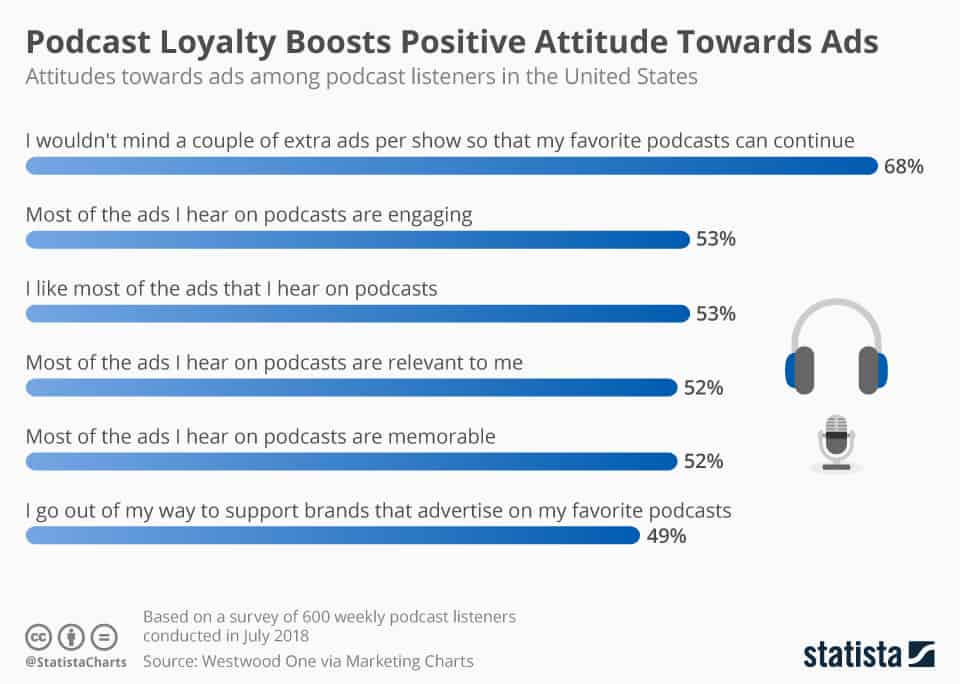If you’re podcasting, there’s a good chance you’re creating other kinds of content as well. You might be blogging, sending email newsletters, posting on social media, vlogging, or doing something totally unique.
Fitting all of your content channels together can be challenging. If you do it well, you can create a comprehensive experience for your audience that adds a lot of value to their lives.
In this article, we help you strategize your podcast content so it fits together with all of your other content.
Action
Read to start your own podcast? Learn the nitty-gritty details of starting your own show in our comprehensive guide. Learn more about starting a new podcast.
Podcasting as the Center of Your Content
We might be a bit biased, but we believe that podcasting should be the central component of your content production. It should be the content channel that leads your other content channels. All of your other content should flow from the podcast.
Think of your podcast like the hub at the center of a wheel. The other content you produce – such as blog posts such as blog posts, social media posts, email newsletters, live streams, etc. – are the spokes of the wheel. This makes your podcast episodes the foundation of everything else you do.
There are four primary reasons that podcasting deserves this central spot:
1. Podcast creates audiences who are more engaged than other types of content
While it’s possible to build an audience that’s loyal to your articles or social media posts, it’s much harder because there’s no direct human connection. The average weekly listener spends 6 hours and 39 minutes listening each week.
What’s the cause of this deep connection? Your human voice. It’s easy for listeners to forget that you’re a business and a brand. They become fans of you, a real human who’s trying to connect with them to solve problems or bring value to their lives. In fact, podcasters are so loyal to their shows that they are significantly more willing to listen to ads in order to get that content.
2. Producing a podcast episode is faster than producing most other forms of content
Once you get the hang of podcasting, it’s actually a quick way to produce content. Once you account for setup and the inevitable mistakes, producing a 30-minute episode shouldn’t take more than an hour.
You’ll need to spend some time editing, of course, but the total time spent is still less than the time it would take to write an article, speak at an event, or design an infographic. In fact, you can even outsource your podcast editing to reduce your time expense.
That said, producing episodes is only quick once you become good at podcasting. In the beginning, you’ll make a lot of mistakes. It’s important to spend some time learning good microphone techniques, building a recording space, and learning how to talk in a manner that doesn’t require a lot of post-production work.
Tip
Castos Productions is the premier done-for-you podcast editing service. Our team of seasoned audio engineers, talented show note writers, and producers will take care of every aspect of your podcast after you record an episode. Learn more about Castos Productions.
3. Podcasts guests make your content a lot better
You may be an expert on your topic, but there are undoubtedly things you don’t know, experiences you lack, and perspectives you’ve never been exposed to. This makes your content biased and one sided, unless you add a guest to the mix.
Quality guests offer unique perspectives and experiences that you ordinarily wouldn’t have. Not only do they make your podcast episodes valuable, but you can use their ideas, anecdotes, and experiences in your other content. For example, If a guest explains an interesting way he solved the problem, you can use that contribution in your other content channels (as long as you cite it properly). This makes all of your content more valuable.
4. Podcast episodes are great places to harvest new content ideas
If you produce a lot of content, you know how difficult it is to come up with fresh ideas. You might come across plenty of topics, but how do you know if they are worth investing in content?
The best way to come up with new ideas is to expose yourself to new concepts by talking to other interesting people. This means the guests you bring on to your podcast are excellent sources of potential topics ideas – for podcast episodes or other types of content.
Furthermore, your guests can challenge your opinions and provide new perspectives. Ultimately, this improves the quality of your content.
But you don’t have to turn these new ideas into more episodes. A guest’s comment might inspire a tweet for your audience to engage with. You might propose one of their questions to your private Facebook group. Or you could insert the new idea into your membership course. There are lots of ways you can use what you learn in your episodes to improve your content.
Grow Your Audience with Castos
Castos gives you all the tools and expert guidance you’ll need to create an incredible podcast that will make a lasting impression for your brand.
How to Fit a Podcast Into Your Content
Okay, so you’re ready to make your podcast the central component of your content. That means developing content starts with your show. Let’s go through what that looks like for your brand.
Step 1. Plan and record your podcast episodes
Since your podcast is the center of your content, your episodes have to come first. Record a podcast episode based on a topic that you think will resonate with your audience. Alternatively, you might choose a topic based on the guests you’ve scheduled for the show. For instance, if you interview a behavioral therapist, your episode would obviously be something about behavioral therapy.
Step 2: Extract new ideas from your episode
Once your episode is complete, the next step is to harvest potential ideas for other types of content. This isn’t something you can do during the recording, because you are usually busy interacting with your guest, reading through your notes, and trying to produce a great episode. So you’ll need to listen to the episode once it’s finished or read through its transcript. (There are several easy ways to make podcast transcripts.)
As you go through the episode, make notes regarding any words, concepts, or ideas that might produce a great piece of content. For example, let’s say you interview a financial adviser who mentions a unique tax strategy. That tax strategy could make the basis for a new blog post.
Keep in mind, however, that not every idea deserves to be an article, video, or podcast episode. Sometimes an idea from a podcast is better suited to a tweet, a LinkedIn post, or a discussion question in your private community.
Check out this brainstorm from Business2Community. It’s a great example of how one idea can turn into many.
Step 3: Create content plans from your ideas
Before diving into creating your new content, take a beat and develop a plan. You don’t need much, just a good idea of what the content will look like before you invest time in it. For example, if you think an idea deserves a blog post or a video, whip up an outline with key points. If you think an idea deserves a Twitter chat, brainstorm the main questions you’ll ask your followers.
Why bother planning? When you create a lot of content, it’s important to think at a high level. You need to know how all of the content supports itself. An idea that references other pieces of content is more valuable than one that’s only loosely related.
Plus, you may start planning a piece of content only to realize the format isn’t right. What you thought would make a good article might only require a Twitter thread.
Step 4: Develop a promotion strategy
Your last step before producing content is asking yourself an important question: “How will I promote it?” The manner you promote your content might influence its creation.
For example, let’s say you decide to write an article based on a concept discussed in a podcast episode. How will you promote it? Well, you may want people to find it on Google, which means you should take search engine optimization seriously. If you decide to post a video on Instagram, perhaps you should create an audiogram.
Step 5: Produce your new content
Once your plans are finished and you know exactly what you want to create, your next step is to actually develop it. Start developing your content based on the plans you created in step three, but don’t let your podcast fall behind. You may intend to produce six blog posts, but if you can only get to two of them before it’s time to work on the next episode, then so be it. Remember, your podcast is the center of your content, so it can’t be ignored.
As you produce content, always refer back to your show. Use phrases like, “As we discussed in episode 37” or “That reminds me of my interview with John Doe.” In fact, don’t be shy about promoting any of the content you create within new content.
Try to maintain the same personality in your content as you exhibit on your show. Your goal is to create a comprehensive experience so your audience can develop a personal connection with you. If you like to be silly on the show, be silly in your blogs, emails, and social media posts too.
Producing lots of content is hard, especially when there are so many things you want to say, so it’s important to create a repeatable workflow. It’s far more effective to produce content consistently than to try to produce too much and end up burning yourself out.
Other Ways to Fit Podcasting Into Your Content Mix
If the “make your podcast the center of your world” approach isn’t for you, that’s okay! It’s still a valuable tool to connect with people, even if you use it as just another channel.
The one piece of advice we’ll give is to NOT use your podcast to reproduce other forms of content. You don’t want to repeat yourself. For example, if you have a blog post titled “How to Start Your First Facebook Ads Campaign,” don’t create a podcast by the same name with that same content. Repeating yourself teaches your audience that there’s no value in exploring everything you produce.
The kind of podcast content you produce will depend on the nature of your show and your audience, but here are some ideas to get your brain thinking:
- Content roundups. Highlight the other things you made.
- Behind the scenes information on what’s happening in your organization.
- Recordings from live events you attend.
- Industry highlights. What’s happening in your space?
- Use portions of your videos’ audio for your show, but add commentary.
- Use portions of articles as loose scripts (but feel free to wander).
As always, make sure to reference the other content you produce . Take every opportunity you can to steer your audience toward other types of content. You can even direct your audience toward specific social media posts if they are popular and relevant.
Add a Podcast to Your Content Mix
Podcasting is a powerful tool to connect with your audience and build an engaged, loyal following. As podcasters ourselves, we can tell you that podcasting is a natural and satisfying way to produce content, so it deserves a place in every creator’s mix. Use the steps we outlined in this article to make your podcast a seamless part of your brand’s platform.





